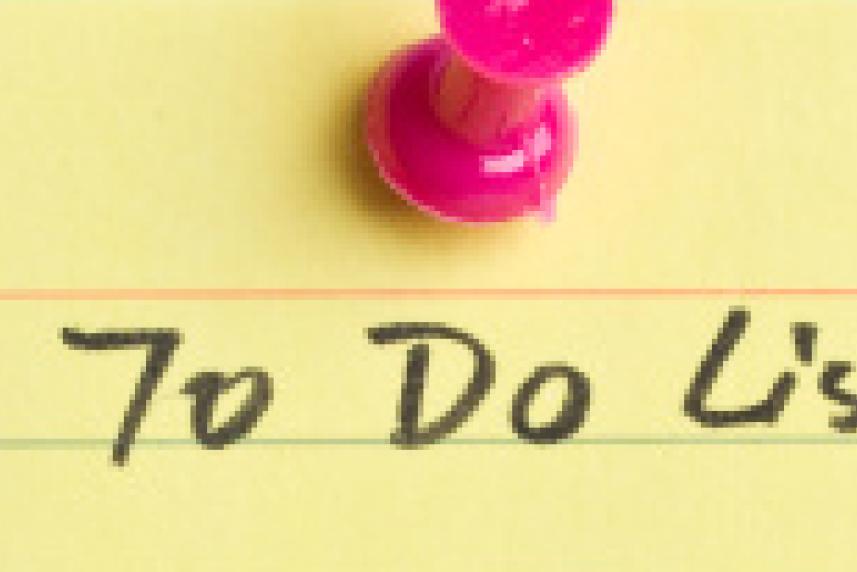Simple ways to improve your memory
Keep your task list on track with tips tailored to your age

After a long day, it can be a bit of a drag when you seem to be functioning with the memory of a goldfish. Stuck in that 3-second loop, constantly forgetting the names of people you've just met, losing your keys after just having set them down…even the most productive among us can sometimes lack a little in the memory and focus department.
Part of the problem has to do with two very different types of information, that which is relevant to the task at hand and that which isn’t. These types of “non-distracting and distracting” information can help in remembering tasks. How you process this information, however, depends on age, and is key to helping to improve your short-term memory and getting everything checked off your to-do list.
Why Age Matters
As we age, our brains simply begin to process information differently, meaning our short-term recall functions differently. "Older adults (ages 60+) have trouble controlling and processing information that is both distracting and non-distracting, so they end up processing two streams of information," says Renee Biss, a third-year PhD candidate at the University of Toronto and author of a study on the success of distraction techniques in helping older adults' memory. According to Biss, because older adult brains don't filter information, they actually absorb seemingly irrelevant environmental cues that can actually help create visual cues to trigger memory.
For example, distraction-based memory tactics suggest that older adults don't have to actively look at the contents of a sticky note to remember the task. They just need it there as a reminder of "something to do." "Say there is a grandchild they have to pick up—a picture of that grandchild can covertly help them to remember," Biss says. They don't need to read something that explicitly states the task. By comparison, young adults (ages 17-30) focus only on non-distracting information, meaning they're more focused on a specific task at a time. Subtle cues that come in the form of distracting information like a familiar image or non-specific sticky notes won't trigger young adults' memory if they're directly focused on a different, seemingly non-related task.
Between the ages of 30 and 60 (middle age), there is a gradual linear decline in most memory and cognition functions—except in terms of vocabulary, which actually increases with age. During the middle years, your brain is transitioning from one way of processing to another, so tactics that work for both younger and older adults can work for middle age adults, depending on the individual.
How to Improve Your Memory
Regardless of age, "one of the most important things you can do for your brain is to keep using it in new and challenging ways," says Erica Perng, a representative for Lumosity, an online brain training and neuroscience company. The San Francisco-based company produces games meant to improve memory and brain cognition. "[Regardless of your age,] the brain can create new connections and improve on core cognitive abilities," Perng says.
According to Lumosity research, older adults need frequent training to maintain and improve their cognitive performance levels. But even younger adults can reap the benefit of brain games—the younger your brain, the more long-lasting benefits result from memory training, Perng says. Online and on-paper games like the crossword puzzle are easy ways to keep your brain chugging along. Depending on your age, there are different types of exercises and tricks that can help improve your short-term memory and help you focus on your to-do list.
For Older Adults
Sticky notes with exact instructions are one tried-and-true approach, but familiar things like photographs and souvenirs can help older adults remember immediate tasks, Biss says. In the study, older adults showed improved memory after they processed distracting information they had seen previously. Older adults could potentially use these sorts of “familiarity cues,” Biss says, to help remember current tasks. Older adults show improved memory in their homes because past associations with souvenirs, furniture, and photographs are strong and can be processed as “distracting information.”
- Memory Tricks:
- Follow a schedule, even with simple daily tasks—brushing your teeth, making the bed, etc. Repeated actions will prompt each other so you won't forget anything.
- Display photographs of people or places you frequent.
- Keep souvenirs or reminders of things you're likely to do again: display grocery receipts to remember to go to the supermarket, leave empty containers on the counter to remember to stock up.
- Set up props to remind you of certain items on your to-do list. If you have to get the oil changed in your car, put your car keys in a prominent place to remind yourself.
For Younger Adults
Because younger adults actively filter out information that is not directly related to what they're immediately doing, use more aggressive reminders to remember what exactly is on your to-do list.
- Memory Tricks:
- Set phone alarms with the exact task spelled out in the alert.
- Keep to-do lists in well-trafficked places at home and at work
- Designate a place to put frequently misplaced items, like your remote or keys. The direct prompt of an empty key dish, with no other association, is a straightforward reminder to put them in there.
For Middle Age Adults
In middle age, adults are transitioning from one way of processing information to another, so experiment with the tricks above and decide what works best for you.


